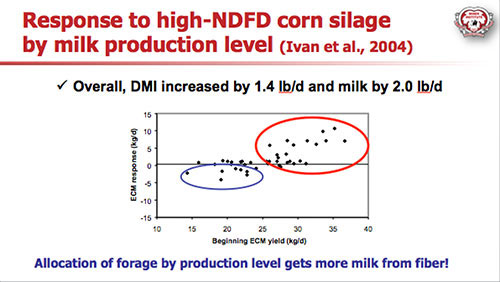 High-quality forage fiber in a milking cow's ration can help milk components, result in fewer metabolic disorders and foot problems and add to cow longevity. It also cut concentrate costs, especially if purchased, which leads to a greater income over feed costs (IOFC), up to a 30 percent difference.
High-quality forage fiber in a milking cow's ration can help milk components, result in fewer metabolic disorders and foot problems and add to cow longevity. It also cut concentrate costs, especially if purchased, which leads to a greater income over feed costs (IOFC), up to a 30 percent difference.That was the focus as Rick Grant, Miner Institute, presented "Milking ration fiber for all it's worth" as the August Hoard's Dairyman webinar. Since growing up on a New York dairy farm, Grant has worked extensively in research and education. He shared some cutting-edge concepts with attendees and challenged them to rethink the way they feed cows.
Which cows benefit most from high quality fiber?
Higher producing cows responded the most with higher neutral detergent fiber digestibility (NDFD) corn silage. Interestingly, there is a trend for cows in later lactation to actually go down in milk production with higher NDFD.

Forage analysis can evaluate many traits. Lignin is one of them. Grant described it as "plant plastic," the indigestible part of forage. However, similar lignin results between forages do not tell the whole story. Lignin percent is a strong indicator of digestibility, but analysis of 30-hour NDFD percent can provide a truer reflection of fiber digestibility.
As ration fiber content rises, the cow will spend more time eating. The longer meal lengths and increased sorting should cause herd managers to reevaluate their pen management. According to research, cows would spend an additional 30 minutes to an hour each day eating higher fiber diets. But, if overcrowding or high stocking densities are an issue on your operation, cows may not be able to eat to their potential and production will suffer.
If grasses are fed, Grant encouraged early cutting as it slows the rate of digestion. Feeding poor quality grass can reduce dry matter intake. Lower intakes and subpar ingredients are a recipe for low production, so harvest grasses early.
As we move forward, Grant is excited about how new research might impact nutrition and ration formulation and impact the cow's response to ration fiber. The speed in which forages break down in the rumen varies, with alfalfa being faster than grasses. However, finding the optimal proportion will be key. Feed stays in the rumen for 35 to 45 hours. During those 40 hours, the cow needs to effectively break down forages for maximum digestibility.
The webinar was sponsored by DuPont Pioneer and is now archived for viewing. Past webinars are available at hoards.com/webinars.

The author is the online media manager and is responsible for the website, webinars and social media. A graduate of Modesto Junior College and Fresno State, she was raised on a California dairy and frequently blogs on youth programs and consumer issues.








